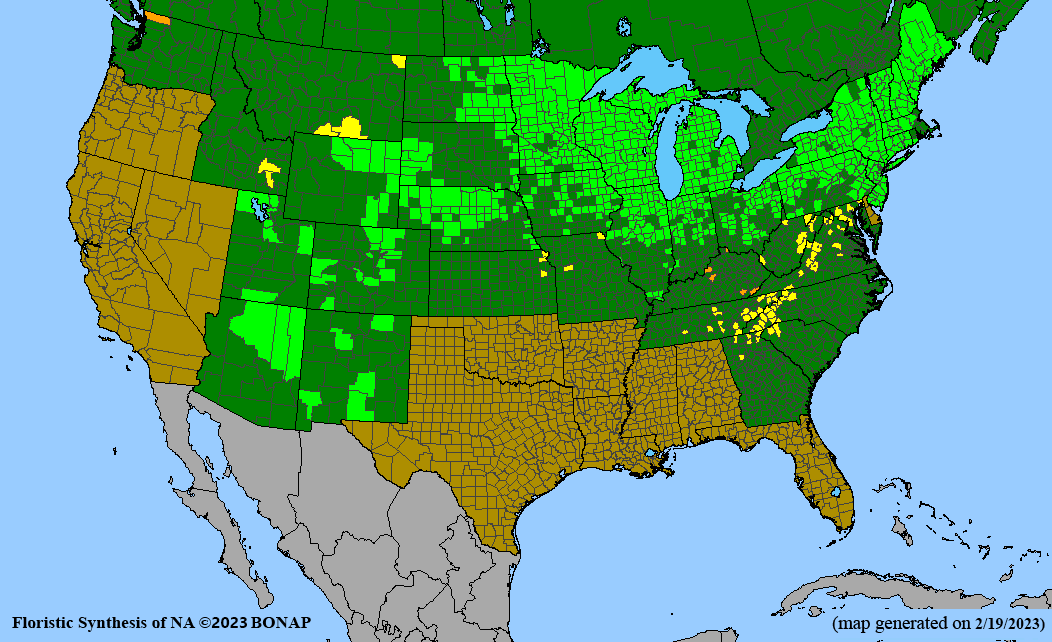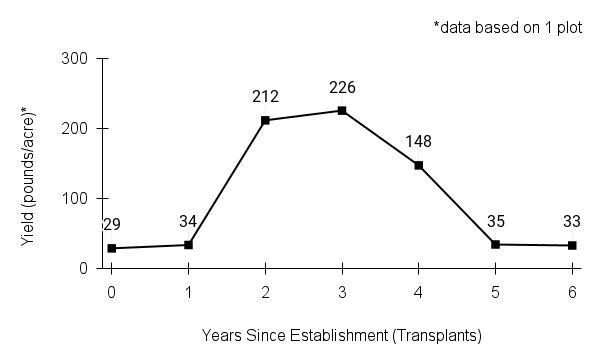spotted joe pye weed
Table of Contents

Eutrochium maculatum (L.) E. E. Lamont
Alternate Common Names: purple boneset, spotted trumpetweed
Scientific Synonyms: Eupatoriadelphus maculatus (L.) R. M. King & H. Rob., Eupatorium maculatum L., Eupatorium purpureum L. var. maculatum (L.) Darl., Eupatorium purpureum subsp. maculatum (L.) Á. Löve & D. Löve, Eupatorium trifoliatum var. maculatum (L.) Farwell
Family: aster or sunflower family (Asteraceae)
Functional Group: forbs (wildflowers)
Description
- Life cycle and growth form
Perennial, spreads slowly by rhizomes to form clumps.
Height: 2-10 ft (mostly 3-6 ft)

- Leaves and stem

Lance-shaped, up to 9 in long with serrated margins, whorled in groups of 4-5 (usually) at each node; unbranched stems purple to purple-spotted (the name ‘maculatum’ means spotted and refers to this trait).
- Flower, fruit and seedhead
Flower: 3-5 small, indistinct florets per head, in flat-topped to domed inflorescences with dozens to hundreds of pink to purplish heads (rarely white); inflorescences appear fuzzy due to the long styles that stick out of the florets.
Fruit/seedhead: Seed clusters ripen from the center outward, becoming tan and fluffy as seed matures; seed is wind-dispersed and susceptible to shattering in windy weather.
Pollination: Insects, particularly bees and butterflies.

- Seed
Seed characteristics
Seeds per ounce: 95,000 (IA NRCS)
1000 seed weight: 0.28 g (Seed Information Database)
Description: Slender, charcoal-gray seeds about 3 mm long with a tuft of tan pappus.
Typical seed test
PLS: 74% (n = 5)
Purity: 86% (n = 5)
Germination: 17% (n = 4)
Dormant: 72% (n = 4)
(averages obtained from n tests of purchased seed lots)
- Habitat and range
Habitat: Moist to wet soil; full sun; wet prairies, sedge meadows, fens, ditches, and other wet places. The USDA classifies it as an Obligate Wetland species in the Midwest region. It benefits from irrigation in production systems.
Conservation status: Global- G5, secure; Idaho and West Virginia- S1, critically imperiled; Montana- S1/S2, critically imperiled to imperiled; Arizona, Virginia, and Georgia- S2, imperiled; Wyoming- S3, vulnerable (NatureServe)

General Comments
The sweet-scented flowerheads attract numerous and diverse pollinators including the endangered rusty patched bumble bee. We once identified seven species of butterflies along a 150 foot row of flowering spotted joe pye weed in one 15-minute observation. Traditional uses of this species by Native tribes include treatments for digestive, urinary, kidney, and women’s complaints and using the hollow stems as straws. The clumped stems and whorled leaves produce dense shade that excludes most weeds from a well-established plot. Irrigation is important for seed production.
Recommendations for Seed Production
- Establishment for seed production
Direct seeding
We do not have experience direct seeding this species for seed production.
Greenhouse
Seed pre-treatment: 60 days cold-moist stratification.
Sowing: Seed is small and should be surface sown or very lightly covered or seedlings will not have enough energy to emerge. If started in germination flats, transplant to individual plugs when seedlings have their first pair of true leaves.
Transplanting: Seedlings are ready to transplant to the field about 8-12 weeks after starting in plugs, when their roots are well-branched and numerous root tips are visible at hole(s) in the base of the plug. Pop out a few plugs to check for adequate root development that will provide sturdy plugs for planting. A week or two before transplanting, move flats outside to ‘harden off.’ (See Propagation chapter in General Information for more details).
- Stand management
Weeds: In the first season after transplanting, weeds are suppressed by a plastic weed barrier. Plants spread by short rhizomes; in second and subsequent years, holes in plastic must be expanded or plastic removed to make room for new stems. Well-established plots shade out most weeds.
Pests: None noted.
Diseases: None noted.
Soil moisture: Irrigation is necessary in most soils to obtain maximum seed yield.
- Seed production
 First harvest: Plants flower and set a little seed the first year when transplanted in spring.
First harvest: Plants flower and set a little seed the first year when transplanted in spring.Yield: 29-226 pounds/acre (based on 1 plot)
Stand life: Peak seed production in years 3-5, but plants are long-lived and vigorous for many years.
Flowering date: late July - early September in northeast Iowa
Seed maturity/Harvest date: second to third week of September
Seed retention: Seeds are wind dispersed soon after maturity, when fluff (pappus) expands in late August through September.
Harvest date range at TPC (2016-2022): Aug 26 - Oct 3
Recommended harvest method: Watch for the centers of seed clusters to begin shattering, and pick early maturing seed heads (clip stalks below seed clusters). If some heads in a cluster are still closed (not fluffy), pull apart a few heads to see if the seeds are dark colored and separate easily from the base (receptacle). Combine the rest of the plot at peak maturity. Turn off air or combine will disperse the fluffy seeds.
- Seed cleaning and storage
Cleaning process: If hand clipped, run dried material through a 1/4 in mesh to thresh seed from stalks. Use a brush machine (medium bristles, minimum vacuum) to remove pappus. Winnow with a box fan to separate seed from most of the pappus and chaff. Airscreen 2-3 times to finish cleaning. See Appendix C for specific settings.
Seed storage: cool/dry (33-50° F, 30-50% RH)
Released Germplasm
Source Identified material: Natural Selections/Iowa Ecotype Zone 1
Cultivated variety (cultivar): ‘Gateway’ is a compact cultivar used in landscaping.
- References
Chayka, K. (n.d.). Eutrochium maculatum (spotted joe-pye weed). Minnesota Wildflowers. https://www.minnesotawildflowers.info/flower/spotted-joe-pye-weed
Eutrochium maculatum. (2024). Prairie Moon Nursery. https://www.prairiemoon.com/eutrochium-maculatum-joe-pye-weed-prairie-moon-nursery.html
Hilty, J. (n.d.). Spotted joe-pye weed - Eutrochium maculatum. Illinois Wildflowers. https://www.illinoiswildflowers.info/wetland/plants/sp_joepye.htm
Kartesz, J.T., The Biota of North America Program (BONAP). 2023. North American Plant Atlas. (http://bonap.net/napa). Chapel Hill, N.C. [maps generated from Kartesz, J.T. 2023. Floristic Synthesis of North America, Version 1.0. Biota of North America Program (BONAP). (in press)]
Lamont, Eric E. (2020, November 6). Eutrochium maculatum (Linnaeus) E. E. Lamont. Flora of North America. http://floranorthamerica.org/Eutrochium_maculatum
Missouri Botanical Garden. (n.d.). Eutrochium maculatum “Gateway.” Plant Finder. https://www.missouribotanicalgarden.org/PlantFinder/PlantFinderDetails.aspx?taxonid=302488&is
Moerman, D. (2003). Native American ethnobotany database. BRIT. http://naeb.brit.org/
NatureServe. 2024. NatureServe Network Biodiversity Location Data accessed through NatureServe Explorer [web application]. NatureServe, Arlington, Virginia. Available https://explorer.natureserve.org/. (Accessed: February 28, 2024).
North Carolina State Extension (n.d.) Eutrochium maculatum. North Carolina Extension Gardener Plant Toolbox. https://plants.ces.ncsu.edu/plants/eutrochium-maculatum/
SER, INSR, RBGK, Seed Information Database (SID). (2023). Eupatorium maculatum. https://ser-sid.org/species/567dc915-c79f-4608-a9d6-e1351ee9a2cb
USDA NRCS National Plant Data Team. (n.d.). Eutrochium maculatum (L.) E.E. Lamont. USDA plants database. https://plants.usda.gov/plant-profile/EUMA9
Species Guide Updated 12/19/2024



